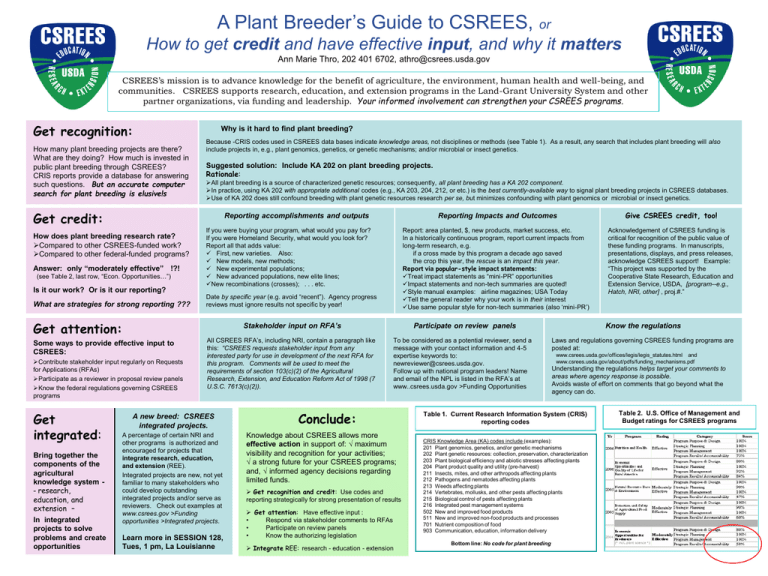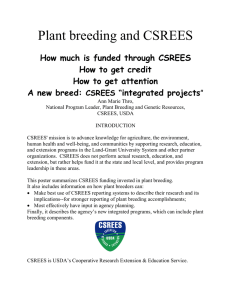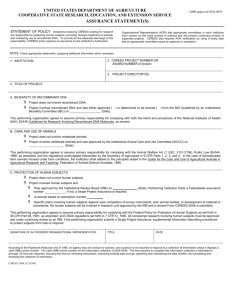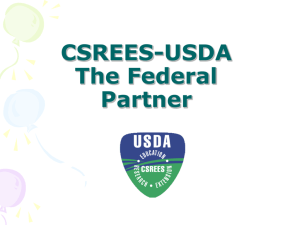A Plant Breeder’s Guide to CSREES, credit or Get recognition:
advertisement

A Plant Breeder’s Guide to CSREES, or How to get credit and have effective input, and why it matters Ann Marie Thro, 202 401 6702, athro@csrees.usda.gov CSREES’s mission is to advance knowledge for the benefit of agriculture, the environment, human health and well-being, and communities. CSREES supports research, education, and extension programs in the Land-Grant University System and other partner organizations, via funding and leadership. Your informed involvement can strengthen your CSREES programs. Get recognition: How many plant breeding projects are there? What are they doing? How much is invested in public plant breeding through CSREES? CRIS reports provide a database for answering such questions. But an accurate computer search for plant breeding is elusive!s Why is it hard to find plant breeding? Because -CRIS codes used in CSREES data bases indicate knowledge areas, not disciplines or methods (see Table 1). As a result, any search that includes plant breeding will also include projects in, e.g., plant genomics, genetics, or genetic mechanisms; and/or microbial or insect genetics. Suggested solution: Include KA 202 on plant breeding projects. Rationale: All plant breeding is a source of characterized genetic resources; consequently, all plant breeding has a KA 202 component. In practice, using KA 202 with appropriate additional codes (e.g., KA 203, 204, 212, or etc.) is the best currently-available way to signal plant breeding projects in CSREES databases. Use of KA 202 does still confound breeding with plant genetic resources research per se, but minimizes confounding with plant genomics or microbial or insect genetics. Get credit: Reporting accomplishments and outputs How does plant breeding research rate? Compared to other CSREES-funded work? Compared to other federal-funded programs? Answer: only “moderately effective” !?! (see Table 2, last row, “Econ. Opportunities…”) Is it our work? Or is it our reporting? What are strategies for strong reporting ??? If you were buying your program, what would you pay for? If you were Homeland Security, what would you look for? Report all that adds value: First, new varieties. Also: New models, new methods; New experimental populations; New advanced populations, new elite lines; New recombinations (crosses); . . . etc. Date by specific year (e.g. avoid “recent”). Agency progress reviews must ignore results not specific by year! Get attention: Stakeholder input on RFA’s Some ways to provide effective input to CSREES: Contribute stakeholder input regularly on Requests for Applications (RFAs) Participate as a reviewer in proposal review panels Know the federal regulations governing CSREES programs Get integrated: Bring together the components of the agricultural knowledge system - research, education, and extension – In integrated projects to solve problems and create opportunities All CSREES RFA’s, including NRI, contain a paragraph like this: “CSREES requests stakeholder input from any interested party for use in development of the next RFA for this program. Comments will be used to meet the requirements of section 103(c)(2) of the Agricultural Research, Extension, and Education Reform Act of 1998 (7 U.S.C. 7613(c)(2)). A new breed: CSREES integrated projects. A percentage of certain NRI and other programs is authorized and encouraged for projects that integrate research, education, and extension (REE). Integrated projects are new, not yet familiar to many stakeholders who could develop outstanding integrated projects and/or serve as reviewers. Check out examples at www.csrees.gov >Funding opportunities >Integrated projects. Learn more in SESSION 128, Tues, 1 pm, La Louisianne Reporting Impacts and Outcomes Give CSREES credit, too! Report: area planted, $, new products, market success, etc. In a historically continuous program, report current impacts from long-term research, e.g. if a cross made by this program a decade ago saved the crop this year, the rescue is an impact this year. Report via popular-style impact statements: Treat impact statements as “mini-PR” opportunities Impact statements and non-tech summaries are quoted! Style manual examples: airline magazines; USA Today Tell the general reader why your work is in their interest Use same popular style for non-tech summaries (also ‘mini-PR’) Acknowledgement of CSREES funding is critical for recognition of the public value of these funding programs. In manuscripts, presentations, displays, and press releases, acknowledge CSREES support! Example: “This project was supported by the Cooperative State Research, Education and Extension Service, USDA, [program--e.g., Hatch, NRI, other] , proj.#.” Participate on review panels To be considered as a potential reviewer, send a message with your contact information and 4-5 expertise keywords to: newreviewer@csrees.usda.gov. Follow up with national program leaders! Name and email of the NPL is listed in the RFA’s at www..csrees.usda.gov >Funding Opportunities Conclude: Knowledge about CSREES allows more effective action in support of: maximum visibility and recognition for your activities; a strong future for your CSREES programs; and, informed agency decisions regarding limited funds. Get recognition and credit: Use codes and reporting strategically for strong presentation of results Get attention: Have effective input : • Respond via stakeholder comments to RFAs • Participate on review panels • Know the authorizing legislation Integrate REE: research - education - extension Know the regulations Laws and regulations governing CSREES funding programs are posted at: www.csrees.usda.gov/offices/legis/legis_statutes.html and www.csrees.usda.gov/about/pdfs/funding_mechanisms.pdf Understanding the regulations helps target your comments to areas where agency response is possible. Avoids waste of effort on comments that go beyond what the agency can do. Table 1. Current Research Information System (CRIS) reporting codes CRIS Knowledge Area (KA) codes include (examples): 201 Plant genomics, genetics, and/or genetic mechanisms 202 Plant genetic resources: collection, preservation, characterization 203 Plant biological efficiency and abiotic stresses affecting plants 204 Plant product quality and utility (pre-harvest) 211 Insects, mites, and other arthropods affecting plants 212 Pathogens and nematodes affecting plants 213 Weeds affecting plants 214 Vertebrates, mollusks, and other pests affecting plants 215 Biological control of pests affecting plants 216 Integrated pest management systems 502 New and improved food products 511 New and improved non-food products and processes 701 Nutrient composition of food 903 Communication, education, information delivery Bottom line: No code for plant breeding Table 2. U.S. Office of Management and Budget ratings for CSREES programs






